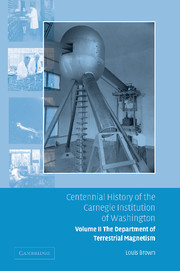Book contents
- Frontmatter
- Contents
- Foreword by Richard A. Meserve
- Preface
- 1 Establishment
- 2 Cruises and war
- 3 Expeditions
- 4 Measurements: magnetic and electric
- 5 The Fleming transition
- 6 The last cruise
- 7 The magnetic observatories and final land observations
- 8 The ionosphere
- 9 Collaboration and evaluation
- 10 The Tesla coil
- 11 The Van de Graaff accelerator
- 12 The nuclear force
- 13 Fission
- 14 Cosmic rays
- 15 The proximity fuze and the war effort
- 16 The Tuve transition
- 17 Postwar nuclear physics
- 18 The cyclotron
- 19 Biophysics
- 20 Explosion seismology
- 21 Isotope geology
- 22 Radio astronomy
- 23 Image tubes
- 24 Computers
- 25 Earthquake seismology
- 26 Strainmeters
- 27 The Bolton and Wetherill years
- 28 Astronomy
- 29 The solar system
- 30 Geochemistry
- 31 Island-arc volcanoes
- 32 Seismology revisited
- 33 Geochemistry and cosmochemistry
- 34 The Solomon transition
- 35 The support staff
- 36 Epilogue
- Notes
- Index
23 - Image tubes
Published online by Cambridge University Press: 06 January 2010
- Frontmatter
- Contents
- Foreword by Richard A. Meserve
- Preface
- 1 Establishment
- 2 Cruises and war
- 3 Expeditions
- 4 Measurements: magnetic and electric
- 5 The Fleming transition
- 6 The last cruise
- 7 The magnetic observatories and final land observations
- 8 The ionosphere
- 9 Collaboration and evaluation
- 10 The Tesla coil
- 11 The Van de Graaff accelerator
- 12 The nuclear force
- 13 Fission
- 14 Cosmic rays
- 15 The proximity fuze and the war effort
- 16 The Tuve transition
- 17 Postwar nuclear physics
- 18 The cyclotron
- 19 Biophysics
- 20 Explosion seismology
- 21 Isotope geology
- 22 Radio astronomy
- 23 Image tubes
- 24 Computers
- 25 Earthquake seismology
- 26 Strainmeters
- 27 The Bolton and Wetherill years
- 28 Astronomy
- 29 The solar system
- 30 Geochemistry
- 31 Island-arc volcanoes
- 32 Seismology revisited
- 33 Geochemistry and cosmochemistry
- 34 The Solomon transition
- 35 The support staff
- 36 Epilogue
- Notes
- Index
Summary
When Galileo pointed his telescope at the sky in 1609 he initiated an optical evolution that continues to the present and shows no evidence of termination. First came bigger lenses with reduced aberrations, then large reflectors that opened the discovery and investigation of objects other than stars and planets, and by the 1890s photographic emulsions had increased sensitivity by allowing the light to be integrated over long periods. The pace of invention has grown geometrically so that the passage of a generation brings startling changes to practitioners of the art. There was a decade and a half when a single device completely transformed observational astronomy, providing improvement that effectively increased the apertures of all telescopes by a factor of three. This device was the image tube, the development of which owes much to DTM.
By 1950 improving the sensitivity of photographic emulsions gave every impression of being in a condition of diminishing returns, but hope seemed to reside in the ratio of two numbers: whereas it required about 1000 photons to produce a single blackened grain in an emulsion, a photoelectric surface will emit an electron for about every five incident photons. Inferior sensitivity was only one of the emulsion's flaws. Its response to light was non-linear, saturation limited dynamic range, heavily blackened regions overwhelmed faint images nearby, but worst of all was an affliction called reciprocity failure, the failure of a long exposure to record a proportionately fainter image.
- Type
- Chapter
- Information
- Centennial History of the Carnegie Institution of Washington , pp. 175 - 182Publisher: Cambridge University PressPrint publication year: 2005



